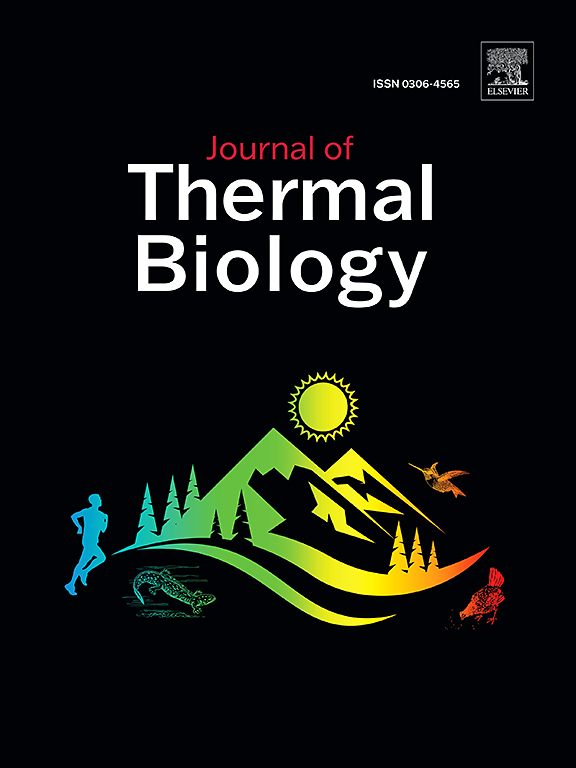Age and mating status have complex but modest effects on the critical thermal limits of adult Mediterranean fruit flies from geographically divergent populations
IF 2.9
2区 生物学
Q2 BIOLOGY
引用次数: 0
Abstract
The highly invasive Mediterranean fruit fly (medfly), Ceratitis capitata (Wiedemann) (Diptera: Tephritidae), is currently expanding its geographic distribution into cooler temperate areas of the Northern Hemisphere. In marginal conditions, the invasion potential of medfly depends in part on innate tolerance to the novel environmental conditions. Physiological tolerances are potentially influenced by interactions among multiple factors, such as organism age or reproductive maturity, sex, and mating status. Furthermore, the relationships between the above factors and tolerances may differ among geographically distinct populations. Here, the effects of age and mating status on thermal tolerance of three geographically distinct medfly populations along a latitudinal gradient ranging from Greece (Crete & Volos) to Croatia (Dubrovnik) were examined. The upper and lower critical thermal limits (scored as loss of neuromuscular function during controlled cooling or heating) of adult males and females (a) at 1-, 6-, 15-, and 35 days old and of (b) both mated and virgin flies were assessed. Results showed that estimates of lower and upper thermal limits (CTmin and CTmax) were both population- and age-dependent. In most age classes tested, CTmin values were lower for the adults obtained from Crete and higher for those from Dubrovnik. CTmax values were lower for the females from Dubrovnik compared to the females from any other population on day one after emergence but not on days 6, 15 and 35. Differences among populations were observed across different age classes both for cold and heat tolerance but mostly in CTmin estimates. Mating status had a little effect on cold and heat tolerance. Complex patterns of thermal limit variation within and among populations suggest a suite of factors determine population-level mortality from thermal extremes under field conditions in medfly. These results contribute towards understanding the invasion dynamics of medfly and its range expansion to northern, more temperate regions of Europe.
年龄和交配状况对来自不同地理种群的地中海果蝇成虫的临界温度极限有复杂但适度的影响。
高入侵性地中海果蝇(medfly),Ceratitis capitata (Wiedemann)(双翅目:Tephritidae),目前正在向北半球较冷的温带地区扩展其地理分布。在边缘条件下,褐飞虱的入侵潜力部分取决于对新环境条件的先天耐受性。生理耐受性可能会受到生物年龄或生殖成熟度、性别和交配状况等多种因素之间相互作用的影响。此外,上述因素与耐受性之间的关系在不同地域的种群中可能会有所不同。本文研究了从希腊(克里特岛和沃洛斯)到克罗地亚(杜布罗夫尼克)的纬度梯度上三个不同地理位置的鳉鱼种群的年龄和交配状况对热耐受性的影响。研究评估了(a)1、6、15 和 35 日龄的成年雄蝇和雌蝇以及(b)交配蝇和处女蝇的临界热上限和下限(以受控冷却或加热过程中神经肌肉功能丧失为评分标准)。结果表明,热下限和热上限(CTmin 和 CTmax)的估计值与种群和年龄有关。在测试的大多数年龄组中,克里特岛的成蝇 CTmin 值较低,而杜布罗夫尼克的成蝇 CTmin 值较高。与其他种群的雌性相比,杜布罗夫尼克种群的雌性在出水后第 1 天的 CTmax 值较低,但在第 6、15 和 35 天则不一样。在耐寒和耐热方面,不同种群的不同年龄段都存在差异,但主要是在CTmin估计值方面。交配状况对耐寒和耐热性的影响很小。种群内部和种群之间热极限变化的复杂模式表明,在田间条件下,有一系列因素决定了鳉鱼种群在极端热条件下的死亡率。这些结果有助于理解褐飞虱的入侵动态及其向欧洲北部温带地区的扩展。
本文章由计算机程序翻译,如有差异,请以英文原文为准。
求助全文
约1分钟内获得全文
求助全文
来源期刊

Journal of thermal biology
生物-动物学
CiteScore
5.30
自引率
7.40%
发文量
196
审稿时长
14.5 weeks
期刊介绍:
The Journal of Thermal Biology publishes articles that advance our knowledge on the ways and mechanisms through which temperature affects man and animals. This includes studies of their responses to these effects and on the ecological consequences. Directly relevant to this theme are:
• The mechanisms of thermal limitation, heat and cold injury, and the resistance of organisms to extremes of temperature
• The mechanisms involved in acclimation, acclimatization and evolutionary adaptation to temperature
• Mechanisms underlying the patterns of hibernation, torpor, dormancy, aestivation and diapause
• Effects of temperature on reproduction and development, growth, ageing and life-span
• Studies on modelling heat transfer between organisms and their environment
• The contributions of temperature to effects of climate change on animal species and man
• Studies of conservation biology and physiology related to temperature
• Behavioural and physiological regulation of body temperature including its pathophysiology and fever
• Medical applications of hypo- and hyperthermia
Article types:
• Original articles
• Review articles
 求助内容:
求助内容: 应助结果提醒方式:
应助结果提醒方式:


